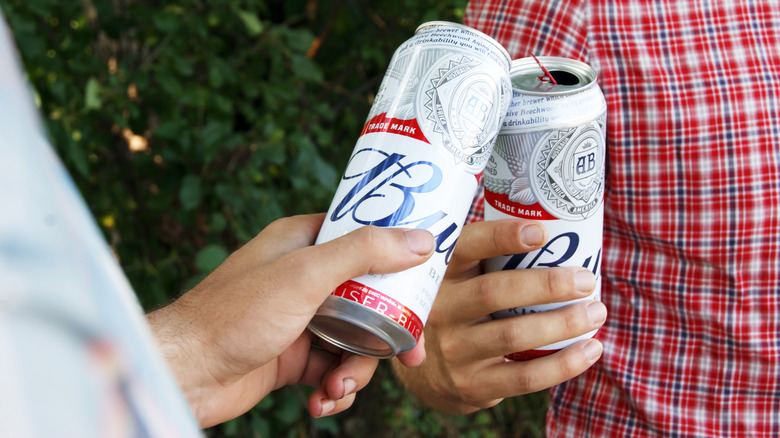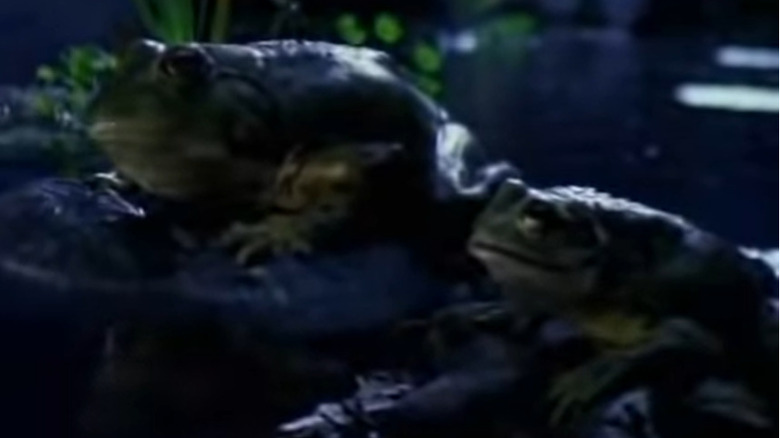Whatever Happened To Budweiser's Beloved Frogs?
If you watched TV in the 1990s, chances are you remember the Budweiser frogs. The simple, catchy commercials featuring three swamp-dwelling amphibians croaking "Bud-weis-er" became one of the most iconic ad campaigns of the decade. First introduced in a 1995 Budweiser Super Bowl commercial, the frogs — Bud, Weis, and Er — quickly became pop culture sensations. You'd think they were just beer mascots, but they were everywhere, from T-shirts to posters to parodies on late-night television.
Though the frogs were killing it with the fans, everything wasn't cotton candy and roses in the court of public opinion. After a bit of pushback regarding the messaging and some concerns over marketing strategies, the folks in power decided it was time to trend in a different direction. Rather than abruptly pull the plug, Budweiser phased out the frogs in a storyline that played out through a series of commercials. The transition was both clever and humorous, giving fans closure while introducing new characters to take their place.
How the frogs got canned
Budweiser didn't just retire the frogs quietly — they gave them a proper send-off. In a 1999 commercial, Louie the Lizard (an earlier side character in the Budweiser swamp) announced to the frogs they'd been "canned." This was a tongue-in-cheek reference to both their removal from the campaign and the fact that beer comes in cans. For the first time ever, the frogs spoke real words instead of just croaking their famous slogan.
Louie's takeover didn't go smoothly, though. In another ad, the frogs got their revenge by using their long, sticky tongues to pull Louie into the swamp, serving up a literal and figurative tongue-lashing. These final commercials served as a creative bridge, phasing out the frogs while keeping audiences engaged with the brand's evolving marketing direction.
After the frogs were gone, Budweiser continued to experiment with humorous animal mascots as well as the "Real Men of Genius" campaign and a new wave of Clydesdale ads. But while Louie and the other characters kept the humor alive, the magic of the frogs remained unmatched. Their short-lived but massive success cemented them as one of the most beloved beer commercials ever.
Why did Budweiser move on?
The Budweiser frogs campaign was undeniably effective, boosting Budweiser's brand recognition and contributing to a strong sales period for Anheuser-Busch. However, there were a few main reasons the company chose to move on. First, Budweiser believed that marketing icons, no matter how popular, had a limited lifespan. While the frogs were a hit in the mid-'90s, Anheuser-Busch was already looking ahead to the next phase of its branding. The company didn't want the frogs to become stale or lose their impact, so the company ended the campaign while it was still popular.
Second, advocacy groups raised concerns that the frogs might appeal too much to children. Critics argued that the cartoonish nature of the ads made them seem more like a kids' TV show than a beer commercial. While Anheuser-Busch never admitted that public pressure influenced their decision, it's likely that the controversy played a role in the timing of the campaign's retirement.
Lastly, Budweiser's advertising style was continuing to change. The company wanted to focus more on human-centered humor and relatable scenarios rather than animated characters. This shift led to new campaigns like "Whassup?" which continued to resonate with audiences in different ways.
Although Budweiser moved on, the frogs have remained a nostalgic piece of advertising history. Their legacy lives on through Super Bowl ad retrospectives, pop culture references, and YouTube clips. Budweiser has continued to come out with new products over the years, but the company manages to satisfy its fans through advertising that continues to evolve.


